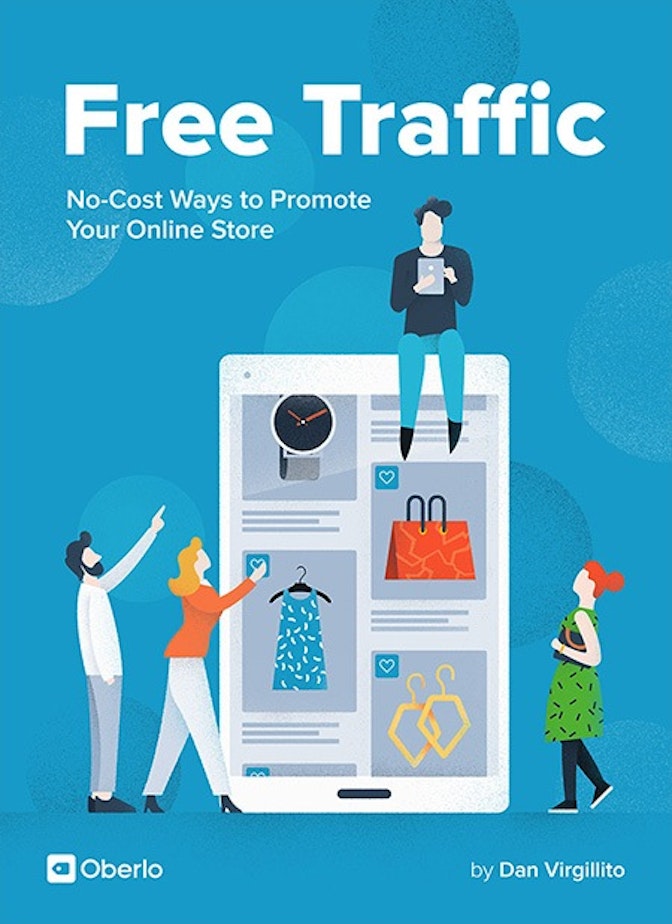Search engine optimization (SEO) can take months to send any qualified visitors. Social media ads can cost a ton of money and are often challenging for the average store owner to set up and manage without hiring a marketing agency or a specialist.
I’m not saying that it’s ineffective to use tactics like SEO and paid advertising through platforms like Facebook Ads and Google AdWords. In fact, they can bring incredible results, and most ecommerce store owners use these more advanced and expensive strategies to drive a ton of traffic and sales. If you’re not familiar, I strongly encourage learning more about these tactics. Here’s our beginner’s guide on Facebook advertising to get you started.
But the thing is, most online marketing tactics require investment and months of research, implementation, and optimization before you see any traffic – and even then, nothing is guaranteed.
But there’s more to marketing than just driving paid traffic. Plus, many new business owners can’t wait that long to take their company to the next level, nor do they have the budget to run a year-long Facebook marketing campaign.
So, what do you do?
You drive free traffic by working strategically with online influencers.
Essentially, an influencer is a person, group, or company that has social clout in your industry and niche. They have a strong online following, and they’re able to capture people’s attention, start conversations, and build strong engagement on their websites and social media channels. When an influencer talks, people listen.
Influencer marketing, which is currently a popular and effective marketing trend, involves partnering with influencers who promote your store. In exchange, you might send them samples or cross-promote their work. These collaborate marketing efforts should be mutually beneficial.
Before you brainstorm different influencer marketing strategies, you need to find influencers who have the right goals, audiences, and engagement levels to suit your brand.. Once you find them, you’ll need to reach out to them in a way that clearly communicates the value of the partnership opportunity without landing in their spam or deleted folder.
To find truly effective and mutually beneficial influencer marketing opportunities, you’ll need to search the vast corners of the internet to find the pockets where your ideal audience is spending time. These pockets can be virtually anywhere, from other ecommerce stores who can potentially be partners to Facebook groups or dedicated subreddits.
One of the key considerations here is to avoid high-traffic influencers. These influencers will have hundreds of thousands of followers, and they’ll want money before they promote your store, instead of building a true partnership. Instead, you’ll want to look for ‘micro-influencers’ and ‘up-and-comers’.
In this chapter, we’ll discuss the main types of online influencers and their key characteristics, how you can brainstorm ideas for the perfect influencer marketing strategies with the right ones for your brand, and some ways to reach out and start building relationships with them.



2.1 Understand Different Types of Online Influencers
To successfully secure influencer marketing agreements and avoid wasting time, you’ll need to hone in on the right opportunities with the right people. That’s why your initial research stage is critical.
First, we’ll identify the different types of online influencers and the key benefits they can bring to the table for different types of ecommerce businesses. Through this lens, you’ll be able to identify specific people to work with and how exactly your brand can benefit.
→ Click Here to Launch Your Online Business with Shopify
Aim for Micro-Influencers and Up-and-Comers
You’ve likely heard the term ‘influencer’ being used to refer to the biggest names in an industry or niche. At least that’s the definition that has been bestowed upon them from the mysterious forces in marketing departments around the world. The term itself suggests an imbalance of power and authority.
While it’s true that these powerhouses have a lot of clout and can help to grow your traffic, it’s also true that many interactions are like paid advertising: it’s a one-way street where your brand is blasted out based on what you can afford.
When you’re looking for a more grassroots kind of strategy that doesn’t involve hundreds or even thousands of dollars spent toward piggybacking on the fame of a household name, your time and resources are better spent looking for micro-influencers and ‘up-and-comers’.
Micro-influencers: Hyper-specific influencers with a lower follower count (roughly less than 25,000) but immensely engaged audiences.
The graphic below highlights why it makes sense to partner with micro-influencers rather than mega social media stars:
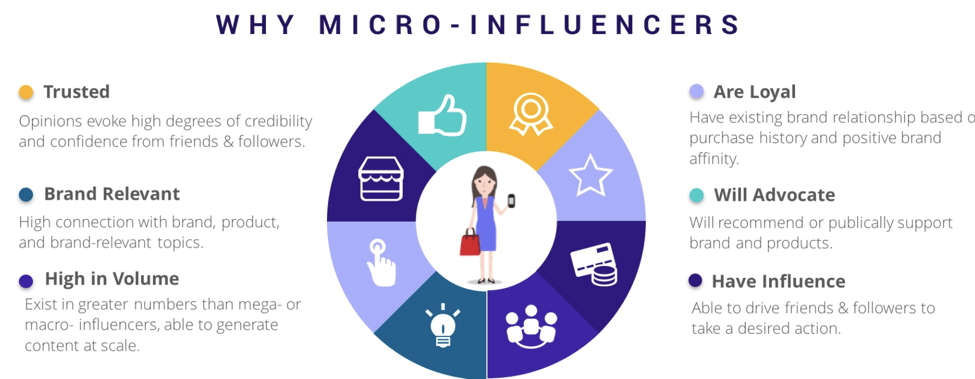
Collectively, the strengths enable micro-influencers to not only attract audiences, but make them take action – perhaps that’s why 82% of consumers are very likely to follow a recommendation made by micro-influencers. This makes micro-influencers the ideal partners when it comes to influencer marketing.
Celebrities and popular influencers expect monetary compensation from the brands they endorse. On the contrary, micro-influencers truly love the brands they collaborate with. An industry survey found that content creators look at a variety of factors when teaming up with brands. Here are some insights:
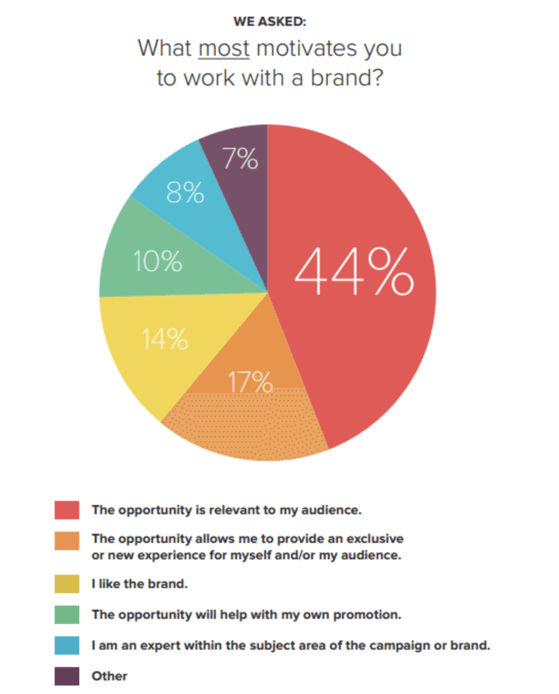
When asked what motivates them to partner with a brand more than once, here’s what they said:
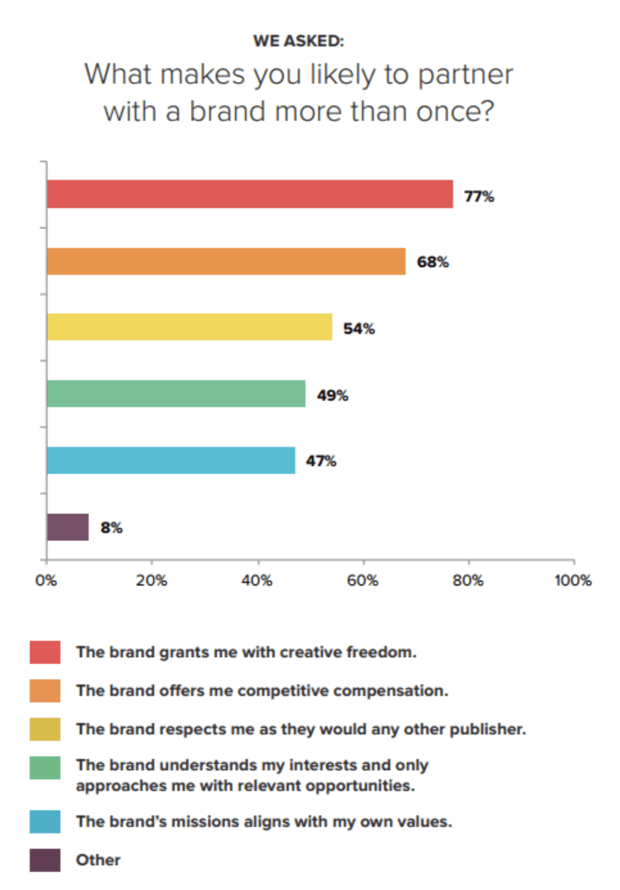
Based on responses from this survey, it’s evident that a good portion of content creators value creative freedom and providing their audiences with relevant content above monetary incentives. Content creators are looking for mutually beneficial marketing opportunities that help them nurture and build relationships with their audience while still aligning with their own personal and professional goals.
Up-and-comers: Just as the name suggests, these influencers are in the early stages of their growth, but they’re on the trajectory to be big influencers. When you partner with these influencers, both parties can benefit from the exposure when they cross-promote one another’s brands. Similarly, both parties can be invested in building an audience together as opposed to a new brand just trying to leverage an established brand.
Generally, up-and-comers will have an independent website and a following of 25,000+ on social networking sites. For instance, Karena & Katrina of Tone It Up are two up-and-coming fitness influencers. They have more than 100,000 followers on Facebook and Pinterest and over a million on Instagram. They also have a website that they update on a regular basis.
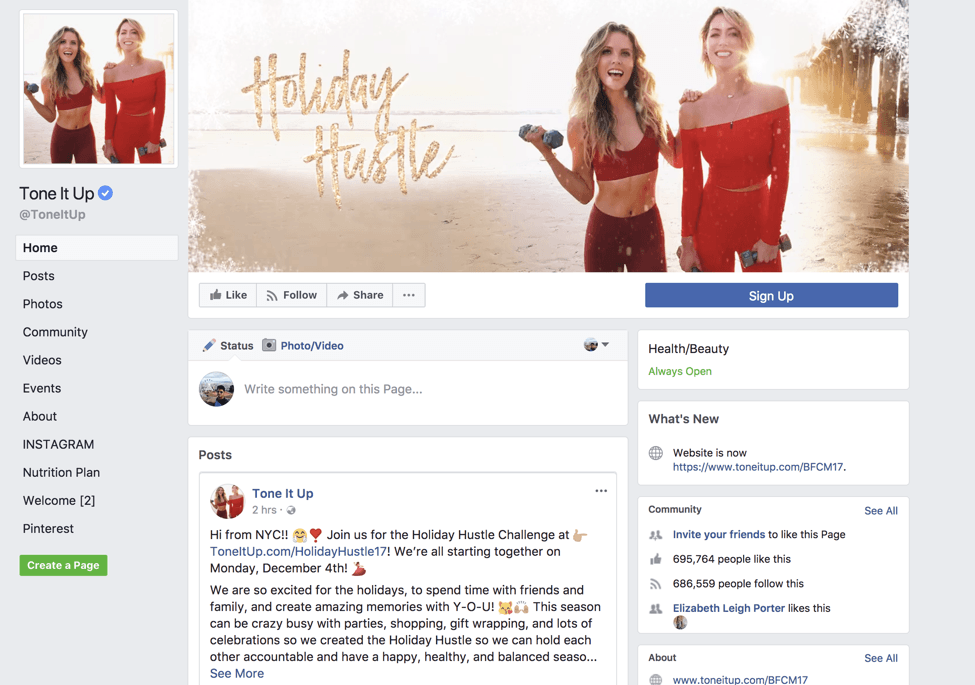
Because they have a larger following and a bigger online footprint than micro-influencers, up-and-comers often charge a fee for branded influencer marketing campaigns. That said, they love creative freedom and presenting fresh ideas to their audiences, just like micro-influencers do.
[highlight]Quick Tip: As you’re building your contact list later, label each contact as a micro-influencer or an up-and-comer. This can help define their audience, scope, and potential partnerships.[/highlight]
The Different Faces of Online Influencers
Online influencers reach out to their audiences in many ways, whether it’s by taking audiences behind the scenes or showcasing a brand’s products during their globetrotting adventures. Half of the time, store owners aren’t even aware that they require help in the decision-making department, which is why we want to explore the different faces of online influencers and how they play into our worlds.

The Adventurer: Someone who enjoys traveling to new, unusual, and fascinating places. They are known for posting some of the most stunning and beautiful photography on social networks. Examples of such influencers include extreme sports enthusiasts, mountain climbers, and wildlife photographers.

The Instructor: These micro-influencers bank on the power of ‘edu-tainment’ to connect with audiences on a more trivial level than other types of micro-influencers. DIY experts, fix-it enthusiasts, remote tutors, and life-hackers who use Snapchat, Instagram, etc. in creative ways fall into this category of micro-influencers.

The Activist: Influencers of this kind see the need for change and devote themselves to doing something about it. To utilize their influence though, you’ll need to go into conversation with an open mind. Civil rights leaders and LGBT community supporters are a few examples of such influencers.

The Entertainer: People love entertainers because of their personalities. They’re often witty characters, commenting on pop culture (music, movies, etc.) or making humorous skits. One example is community-based comedians. However, not all entertainers are funny. They may also be confessional, influencing people by sharing parts of their lives.

The Disruptor: Disruptors have an open mind and willingness to explore uncharted territories. They love to work with businesses that further the debate and help them take creativity to new levels. Examples of disruptors include virtual reality enthusiasts, electric car racers, and cryptocurrency reporters.
Qualities To Look For in Micro-Influencers and Up-and-Comers
When you start your search for potential influencer marketing opportunities, you’ll likely feel like you’re swimming in an abyss of blogs, websites, and social media accounts. To find your brand’s best options, you’ll need to be observant, detail-oriented, and purposeful. In other words, you’re going to need to put on your ‘internet stalker’ hat: let’s face it, we all have one lying around here somewhere.
The best influencers share the following character traits:
- Credibility. Micro-influencers and up-and-comers are experts in their niche. These personalities should ooze this in their online presence, and answer the questions that their audience is asking. If you can’t trust their opinion and outlook, they probably aren’t suitable for influencer marketing partnerships.
- Likeability. The most successful influencers are the people you can imagine yourself having a coffee or a beer with. Their personalities are authentic, engaging, captivating, and inspiring – and this is part of the draw for snagging and keeping their audience base.
- Ingenuity. Many influencers pave the way to their success by offering a unique or creative take on the status quo. They’re invested in solving problems or making improvements in their niche, and their strategy for doing so often involves open-mindedness and curiosity for exploring new perspectives, tools, and strategies.
- Passion. It should be pretty obvious that they love what they do. In a sense, passion is a culmination of all of the above qualities that manifest into their unique presence. A passionate influencer motivates their audience while they experiment and collaborate to achieve their own vision.
Apart from the general feel of their channel and the persona they convey, you’ll also want to examine key characteristics of their channels and content that qualify them as micro-influencers and up-and-comers. These details include posting habits, views and audience engagement, content quality and the like.
The most identifiable traits typically include:
- Regular content publishing (blogs, videos, podcasts, etc.) at least once a week, with the last item published no later than a week ago
- A highly-engaged audience including likes, comments and other interactions, and shares if the channel permits
- Decent or high-quality web design, photography, video and/or audio clips
Look at the evolution of their content. How long ago was their first publish date? What’s the progression of views and interaction since then? Look for spikes in engagement that indicate that an up-and-comer has crossed the threshold of growth and popularity.
For YouTube personalities and vloggers, look at their channel and see how their views have grown from video to video. For other types of content, see how many more likes, comments, and shares they’ve gotten along their timeline since they first started out.
Check to see if your prospective partners are already involved in influencer marketing. Have they recently started promoting products, brands, or other individuals? A fresh step into the promotion realm is a huge window of opportunity and a great indicator of crossing the threshold. It’s also a perfect sweet spot for you to propose an influencer marketing opportunity before the influencer’s demand is so high that they jack up their prices for participation.
Above all else, be picky. It may take some time to find the perfect influencers, but they’re more than worth the wait if they reflect and amplify the strengths of your brand.
2.2 Brainstorm Collaboration Ideas with the Right Types
Now, it’s time to propose some influencer marketing opportunities to the right content creators.
Before you make any moves, you’ll want to think about which types of influencers mesh well with your brand and how specifically you can work with them. Viewing the research phase through this lens will help you find influencer opportunities with people who really fit your brand.
Consider strategies like:
- Voicing your brand by publishing content on their blog or appearing as a guest on their podcasts
- Sending samples with handwritten notes to have your products reviewed
- Pitching a giveaway or contest involving your products
- Meeting up and promoting at a relevant event (if you’re local)
Keep in mind that this is by no means an exhaustive list. While you’re thinking about your own brand’s personality and goals, and learning about the influencers in your niche, keep an open and creative mind to dream up new and original collaborate marketing opportunities. Uniqueness is a goal, not just a side effect – standing out is an asset for building quality partnerships and generating excitement and engagement from your future customers.
Build Your Own Branding Database
We’ve discussed that it’s critical to align your company with influencers who share the same values, traits, and goals. But how do you know it when you see it? By being clear on your own brand identity, in explicit terms.
Before you start your external research, do some internal research.
Map out the key elements of your ecommerce store’s brand and where you see yourself in the long run by asking yourself questions like:
- What are my brand’s core values and mission statement?
- What benefits do we offer to our customers?
- What’s my brand’s personality? Fun, professional, educational, etc?
- What makes us different from the competition?
- What are the visual elements of the brand? Colors, fonts, visuals like photos and illustrations, etc?
- Who are our ideal customers?
- How do we immediately communicate to customers that we’re the right choice?
Make sure to write all of these answers down. That way, you’ll always have a reference sheet to ensure that every move you make is working toward your ultimate goals. It’s essential to understand your brand before proposing influencer marketing opportunities. In the next phase of looking for specific influencers to reach out to, you’ll be able to include these terms in your searches on various channels, platforms, and tools to find influencers who align with your brand.
Think of this section as a critical thinking exercise for foundational brand-building.
While your brand can be built and honed for all of eternity, we’ll start with three main elements: basic keyword research, hashtag research, and brand personality traits.
[highlight]Quick Tip: Create a brand identity spreadsheet to organize all of the terms you come across during this phase of research. That way, you’ll be able to easily copy-and-paste them into your searches on your quest for finding influencer marketing opportunities.[/highlight]
- Basic Keyword Research
If you’re familiar with search engine optimization (SEO), you’ve likely heard of keyword research. For any online endeavor, keywords play a massive role in how search engines work, and how they choose to display specific web pages when people type something into a search bar.
You could say that keywords are part of the language of the internet. Simply put, researching and using the right keywords across all forms of your online presence can result in more traffic and exposure.
This same concept applies to finding partners for influencer marketing opportunities. When you use precise keywords in your search to find influencers on various platforms, you’ll get more relevant results that align closely with your brand. You can cut through the clutter to find good influencers more quickly and easily.
You’re also likely aware that keyword research can be a massive beast to tackle when you’re using traditional SEO strategies like website optimization or paid advertising tools. While it can be helpful in the long-run, SEO strategies typically don’t offer immediate traffic benefits. So for right now, we’ll only cover the basics of keyword research and how you can use it in the context of snagging influencer marketing partnerships.
As you’re skimming through hundreds of keywords, use the relevance litmus test. Ask yourself: is this 100% relevant to my brand? If a user searches for this keyword and lands on your site, will they find exactly what they’re looking for?
Google Search Suggestions
Google can be pretty darn helpful for suggesting keywords, because its suggestions are based on the top searches related to your initial keywords in the geographical region you’re in when you conduct the search. Type in the main keywords, then examine the dropdown suggestions.
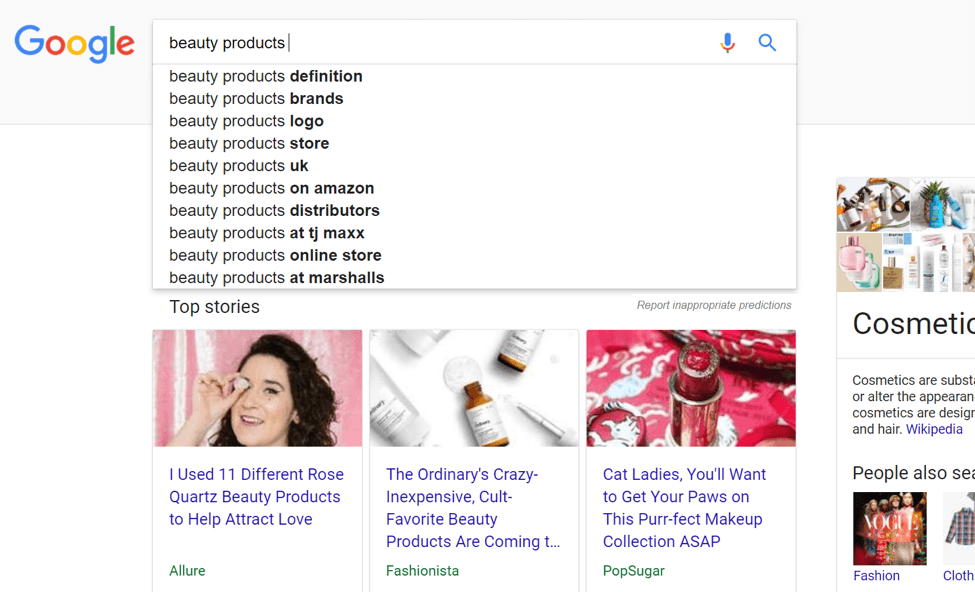
You can also look at the bottom of the page, which shows variations that don’t necessarily start with the words you entered into the search bar.
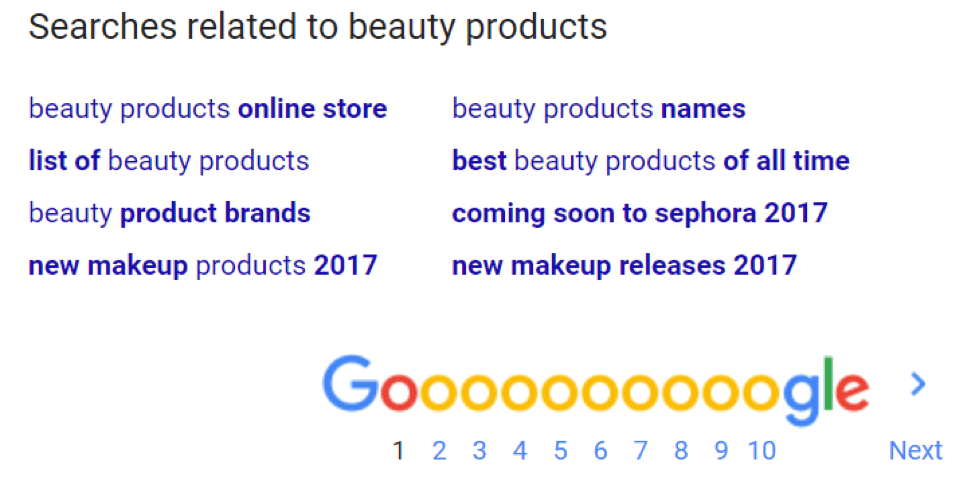
[highlight]Quick Tip: Google suggestions are based on your current region by default, but you can change the settings if you plan to sell internationally and want to see suggestions for another region. Underneath the search bar, click ‘Settings’ → ‘Search Settings’ then scroll to the bottom of the page. Go to ‘Region Settings’ and select the region you want to see suggestions for. [/highlight]
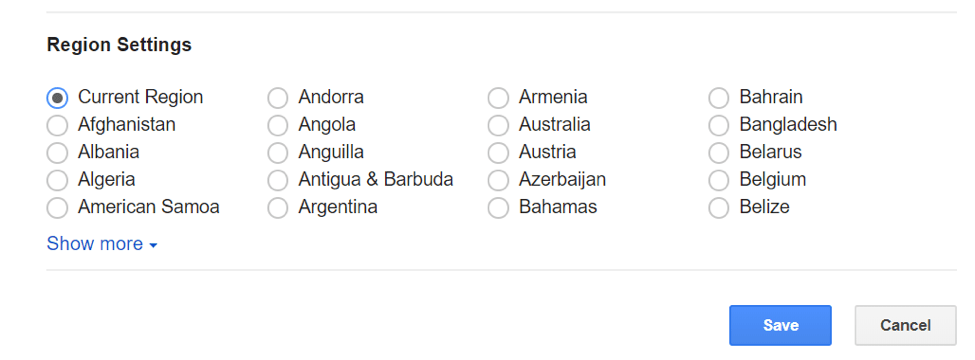
Übersuggest is another awesome tool for keyword suggestions. Just type in your main keywords and it will return hundreds of related keywords, sorted alphabetically.
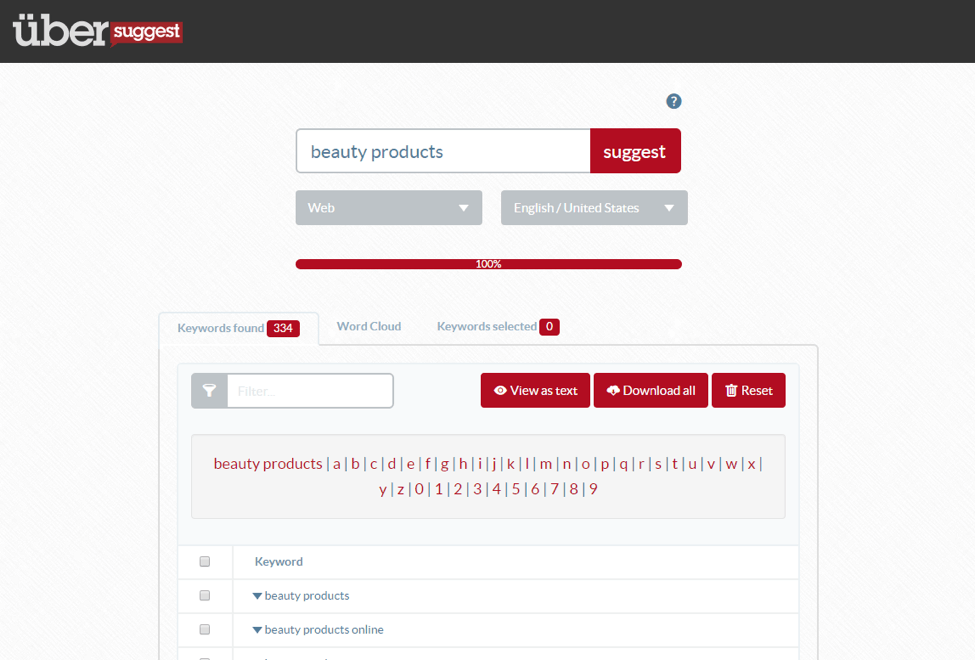
- Hashtag Research
If keywords are the language of the internet, hashtags are the language of social media. Hashtags offer the same benefits as keywords: you can use them to find exactly what you’re looking for. The added benefit of hashtags is that they’re directly clickable, which helps you to connect with other accounts and users without the guesswork that SEO-style keyword research might involve.
And there’s no way around it: you need social media and social media needs you. Having a list of go-to hashtags can help you find the pockets where users are really engaged around your niche, and can be a speedy way to identify the influencers who are the center of conversation in those pockets. If you search for a popular and relevant hashtag, you’ll often find promising influencers who are using them. Then you can evaluate these accounts to see if they’ll be a fit for influencer marketing.
To make sure you find all the best hashtags, you can use some hashtag research tools. They’ll tell you popular trending hashtags around your niche so that you don’t have to guess. Plus, once you know the good ones, you can use them regularly in your own social media posts.
Picodash is a cheap tool ($8 a month for the basic plan) that lets you search Instagram hashtags. When you type in a hashtag, you’ll see several results for related searches as well as the volume of users who’ve posted with that hashtag. You can drill down by keywords within the post, location of the users, user profiles, date and time posted, and even likes and comments.
Say you’re an outdoors store selling hiking gear. You can type #hiking and filter by keywords like ‘mountain’ or ‘camping’ to see how popular the results are, and which hashtag variations are being used.
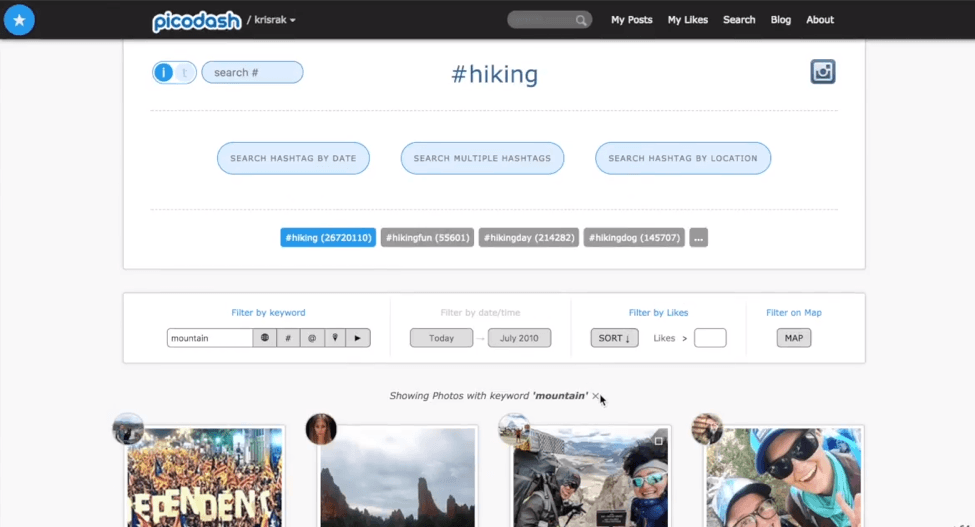
This is another great hashtag search tool. This one includes Twitter in addition to Instagram. You can use the free search functionality to see if it’s helpful, then sign up for the basic membership for $9 a month.
It shows results based on popularity, recent popularity, how the hashtag is trending this month or week compared to last, and top influencers related to these hashtags. Conduct a few searches related to your brand and investigate these influencers who use the hashtags. You might find a few golden partnership opportunities!
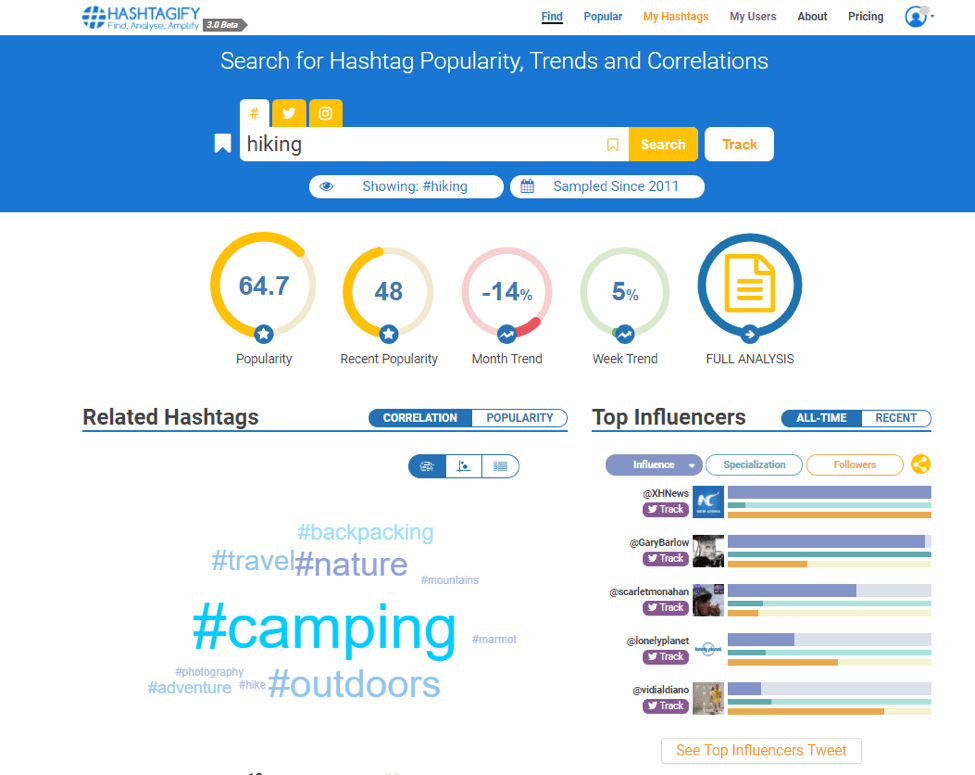
- Brand Personality Traits
What’s your company like? What are the main draws that will attract your ideal customers, and what are those customers like? What are their interests and needs, and what kinds of brands do they prefer to do business with?
Think of a list of adjectives and nouns that represent your company’s philosophy, ideals, and goals, as well as those of the ideal customers you’d like to attract. Words like:
- edgy, fringe
- eccentric, offbeat, alternative
- free-spirited, spontaneous
- hippie, bohemian
- opinionated, controversial
- educated, intellectual
- empowering, inspiring, motivating
- eco-friendly, green, sustainable
- creator, designer, producer
- disruptive, innovative
- leader, trend-setter
Once you have a list of these words, you can include them in your search engine and social media searches to help find promising influencers. Chances are, they’ve used the same types of terms to describe their own web presence, or you’ll find that others have used these terms to describe them.
For example, if you’re an eco-friendly makeup company looking for someone to review your products, you can search a term like ‘eco-friendly beauty product reviews’’ You might find an influencer who aligns with your values and thus, the perfect candidate for an influencer marketing campaign.
Connect the Dots: How Your Brand Fits with Theirs
Now it’s time to explore the different types of partnerships that are available. You could even come up with some of your own if you’re feeling inspired.
Back to the beauty brand example. Say you’re looking to be included in videos, but you see that there are different types of videos and you’re not sure which ones are the best fit for showcasing your products.
Take a look at some common types of beauty videos, and which brands and products they might fit snugly with.
| Style guides and lookbooks | Special seasonal lines and products, like spring and fall makeup collections |
| First impressions | Unique or innovative products, so that influencers can reveal it to their audience and position it as a possible new trend |
| Unboxing | Subscription box brands, so that audiences can ‘experience’ the excitement of the unboxing process and explore the product offering |
| Do-it-yourself (DIY) | Beauty supplies or skin/hair care ingredients, so that you can pitch the influencer a DIY project that involves one or more of your products |
| Tutorials | Virtually any type of product: unique/innovative or more common products, so audiences can see the final result in action |
These concepts can also apply to channels like blogs, podcasts, social media posts, and other types of content. For example, style guides, gift guides, and lookbooks are often curated with several brands and published on websites and as downloadable PDFs.
Contests, Giveaways, and Joint Promotions
Aside from having your products tested, reviewed, and featured in relevant content, you can also try pitching special events like contests or giveaways for your products.
A common influencer marketing technique is to offer the influencer a coupon code that their audience can redeem. Give them a free sample of your product to include in a contest or giveaway, or use their channel as an entry into your own contest (for example, commenting on their social media post counts as an entry into your contest). This is a great way to cross-promote: your brand promotes the influencer, while the influencer promotes your brand.
Take for example Shoes of Prey, a shoe brand that lets users design their own shoes. The company teamed up with Blair Fowler, a then-16-year-old beauty vlogger who agreed to host a giveaway on her YouTube channel. In the video, she showed viewers the pair of custom shoes she designed for herself, along with a quick tutorial for how to use the website to build their own designs.
The result: over half a million video views, coverage on Business Insider, The Wall Street Journal, and Media Gazer, and sales numbers that permanently tripled!
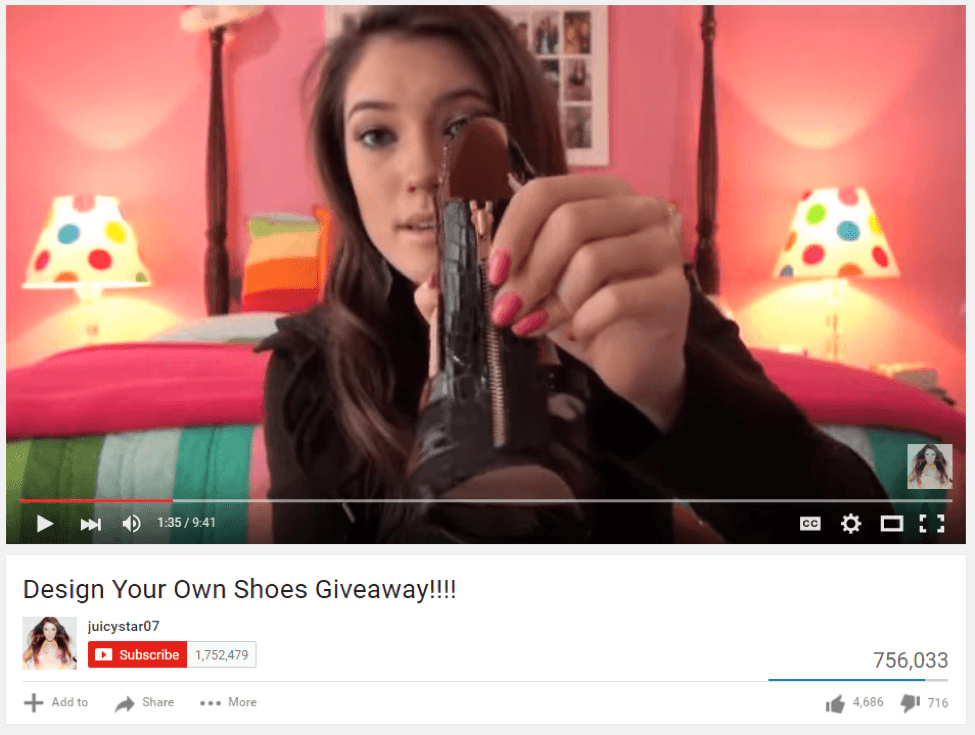
Other influencer marketing ideas might include:
- Having the influencer curate a special product collection, labeling it with their name, and including it on both of your sites, content, and marketing materials
- Offering them a cut of sales for a product or promotion in exchange for mentioning it
- Strategic product placements in their social media posts
[highlight]Quick Tip: Whenever you get an idea about a new niche or audience segment that might be able to connect with your brand, write it down. This master inspiration list should evolve and stay with you forever – no matter what stage your brand is in, new ideas for growing your network will never become obsolete.[/highlight]
2.3 Conduct Deep Research to Find Partner Prospects
At this point, you can identify different types of online personalities, and your hamster wheel is turning over the right ones to partner with and the specific types of partnership opportunities you might benefit from pursuing.
Now it’s time for some good old-fashioned research: digging into the web to actually find influencers. I’m not going to sugar coat it. This will involve getting lost in the depths of the interwebs for several hours. But since we’ve nailed down some context and you know what you should generally be looking for, you’re geared to make the most of your time invested.
In this section, we’ll discuss how to scour some of the top channels, platforms, and tools for finding potential partners, including:
- Web searches on Google and YouTube
- Social media searches on Instagram, Snapchat, and Pinterest
- Specialized search tools like Right Relevance and Feedly
Start with some targeted Google searches to find curated lists that can steer you into the right direction. If you’re unsure of who exactly you need to be reaching out to, this process will help. As you scan through your potential influencer marketing candidates, you’ll be better able to visualize how partnering with them may or may not work.
Say you’re looking for up-and-coming beauty bloggers. Use keywords focused around ‘up-and-coming’ and ‘new,’ and then mix-and-match different brand identity terms you developed in the previous sections.
Search for queries like:
- up-and-coming beauty bloggers
- new beauty bloggers
- promising beauty bloggers
- best beauty blogs right now
- edgy up-and-coming beauty bloggers
- creative new beauty bloggers
- growing eco-friendly beauty bloggers
In a Google search, click ‘Tools’ → ‘Any time’ dropdown to make sure your results are recent. Try results from the past six months, as the crossing the threshold has a critical time factor. An up-and-comer from a year ago has probably either sank or swam by now.
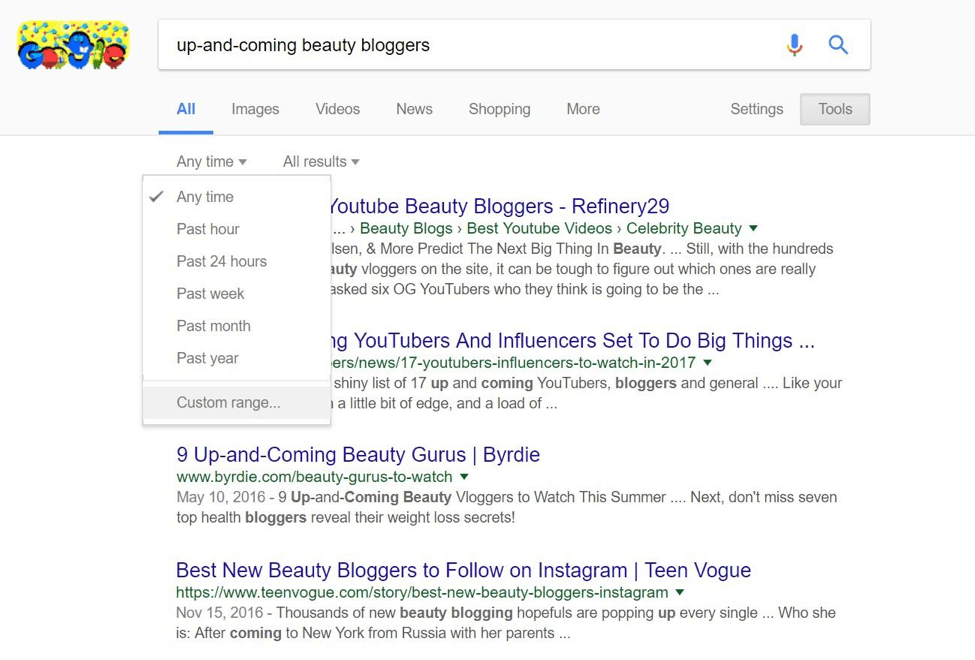
[highlight]Quick Tip: Google search operators are your friend. For example, if you keep seeing high-profile influencers instead of up-and-comers, try using an operator like the minus sign (-): type ‘-best’ to show results that don’t contain the word ‘best’. See a full list of operators to supercharge your searches.[/highlight]
Don’t stop at page 1 of the search results. Dig into 3-5 pages for each search you do to make sure you’re not missing any good results. Just because these personalities haven’t made it to the front page doesn’t mean you shouldn’t consider them for influencer marketing. In fact, if they’re in the early up-and-coming phase, they won’t be on the first page yet!
As you’re digging deeper, vary your search requests. Replace the word ‘blogger’ with other types of content creators like:
- vlogger
- YouTuber
- journalist
- photographer
YouTube
Depending on your industry, vloggers might be an ideal route. This is especially true for the beauty, health and fitness, and entertainment industries. According to Think with Google, 62% of consumers watch product review videos before making a purchase, so you can score big if your products get a cameo.
YouTube searches will be different from Google searches in that you won’t find the same helpful curated lists and articles as you do using Google. With YouTube, you’re best off searching channels and videos individually.
Like Google search, use filters. Click the ‘Filter’ option at the top right corner. Try filter options like:
- ‘Type: Channel’ to search by user.
- ‘Type: Video’ to see videos that have gone viral and crossed the threshold for the user.
- ‘Sort by: View count’ – scroll down past the high-profile channels and videos, as these are most likely already online influencers. Look for channels and videos with views in the thousands or tens of thousands.
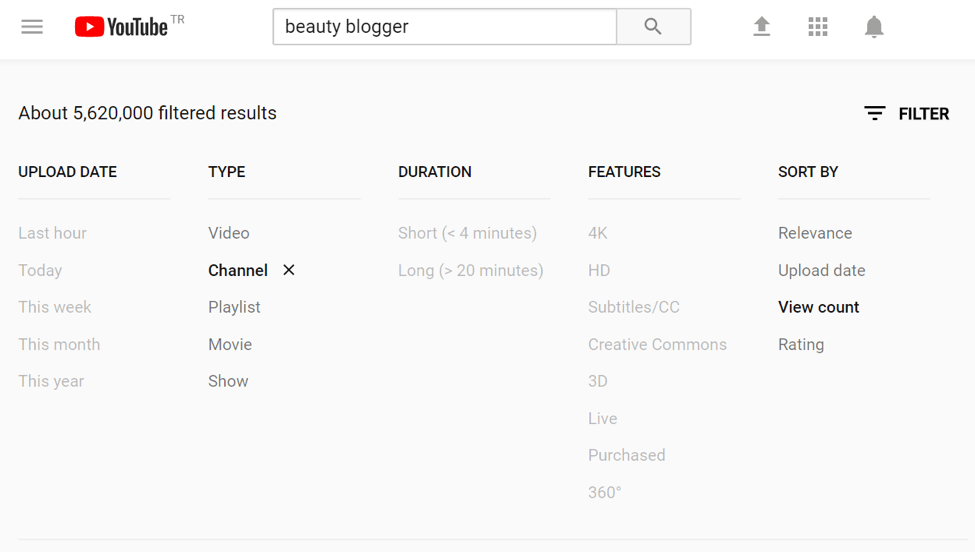
Both micro-influencers and up-and-comers love Instagram. For them, it’s a valuable channel for communicating with their audience where it’s less about dialogue, and more about photo and video sharing. An image and a few words can convey a lifestyle, take the audience on a journey, and/allow the community to witness and experience the unique things Instagram influencers get to see in their reporting.
You can find all types of influencers on Instagram. Of course, the ones you look for will depend on the niche you’re targeting. Here are a few helpful tips to help you with your search.
Look Among Your Fans
There’s a good chance that your ideal influencer is already following you on social media. You can find him/her by exploring your list of followers, and checking out the user profiles which seem relevant to your brand. The easiest find is their profile photo or username.
For instance, if you’re selling cosmetics or makeup items, you might want to check out followers with ‘makeup’ or ‘make up artist’ in their username.
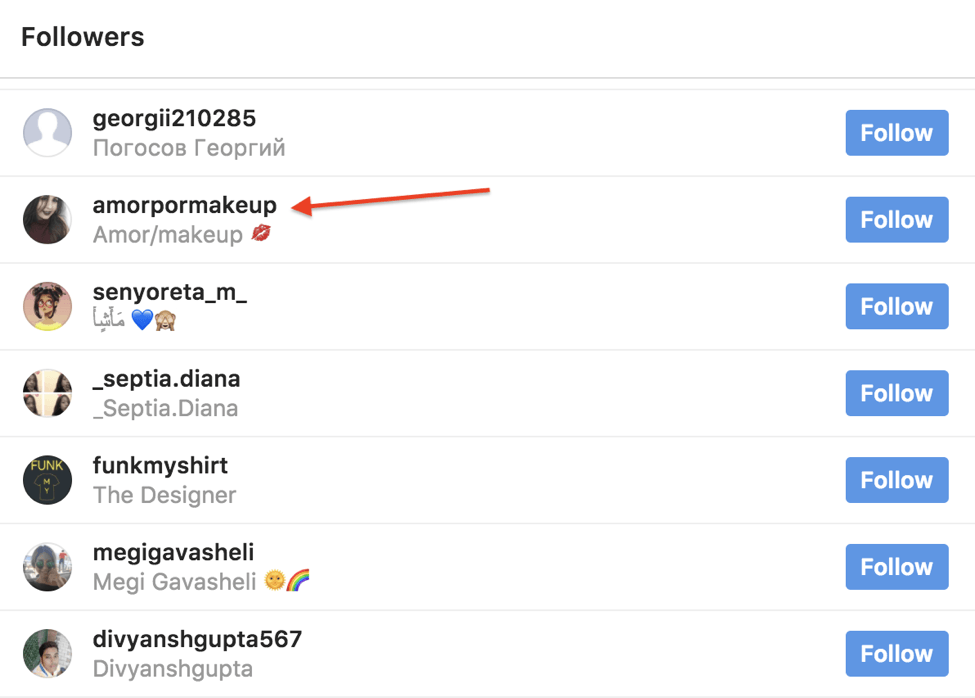
The above list contains someone whose username is @amorpormakeup who could be a potential influencer for an ecommerce store selling beauty products.
If the influencer has less than 30,000 followers and minimum press coverage but high audience engagement, you’ve probably spotted a micro-influencer.
Use hashtags
One of the easiest ways to find relevant influencers on Instagram is by conducting a hashtag search. For instance, searching for the hashtag #travelbloggers will lead you to the micro-influencers and up-and-comers associated to that hashtag.
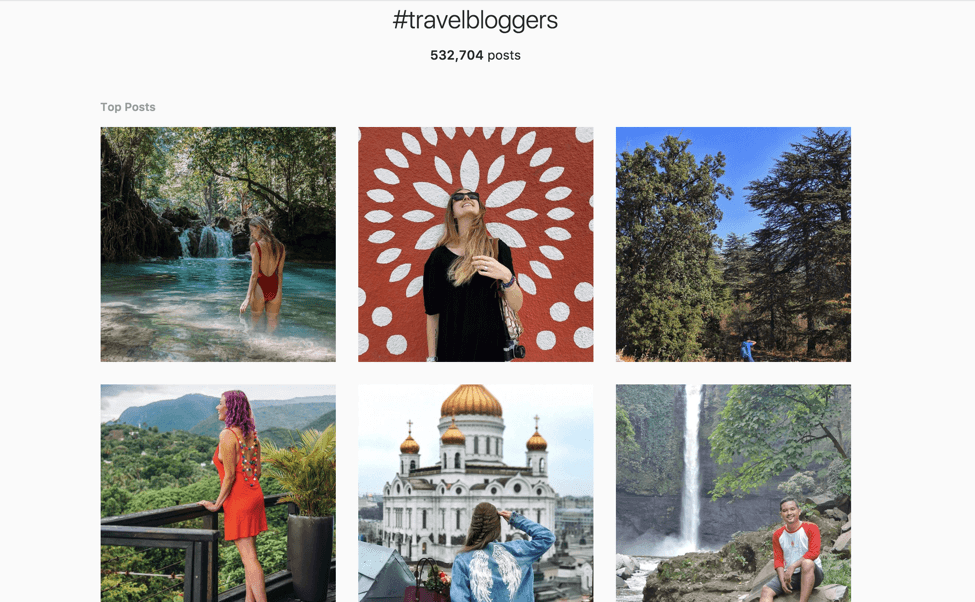
One of the search results is an image of Sebrin Elms, a travel and lifestyle blogger with more than 25,000 followers. She could be an ideal influencer for an ecommerce store selling travel gadgets or lifestyle products.

Sebrin also has a blog, and a quick search on Google for her blog’s name reveals she has been featured in a variety of online publications. We can deduce from all of these details that she’s an an up-and-coming adventurer, and might be an excellent partner for influencer marketing campaigns if her web presence and values align with your brand.
Snapchat
Home to a plethora of social media stars, Snapchat has become more of an influencer network in recent times. Snapchat influencers are creative, self-made digital celebrities who have a close-knit relationship with their followers. They’re skilled with Snapchat’s features and understand the importance of leveraging emojis and animated lenses. You’ll find all sorts of influencers on Snapchat including entertainers, advocates, instructors, and more.
We’ve listed below some tips to help you find the right Snapchat influencers for your marketing campaigns.
Perform a Google Search
Because Snapchat doesn’t offer details of users the way other social networking sites do, it can be challenging to find relevant micro-influencers and up-and-comers. Instead of battling Snapchat on your smartphone searching for influencers, a better option is to use Google.
Search for the following strings:
- list of [industry name] influencers on Snapchat
- Snapchat [industry name]
- [industry name] influencers to follow on Snapchat
- best [industry name] Snapchat accounts to follow
To give an example, if you sell maxi dresses, you can search for ‘Snapchat fashion’ in the search engine. Here’s what Google returns for this search:
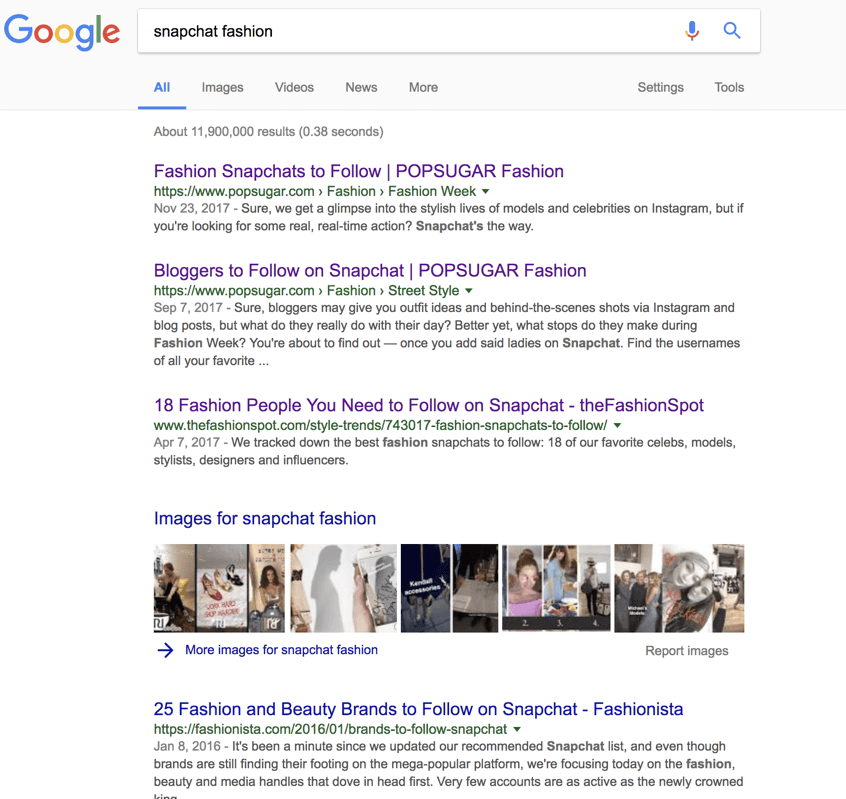
Several publications have curated a list of fashion influencers to follow on Snapchat. It’s in these lists that store owners can find the right influencer to partner with. For instance, if you click on the second result in the list – i.e. ‘bloggers to follow on Snapchat’ – you go to POPSUGAR Fashion. The site presents you with a list of online influencers in this niche.
Go to an Influencer Marketplace
One of the most effective ways to discover relevant Snapchat influencers is to use influencer marketplaces. These are technology platforms that use artificial intelligence to connect brands interested in reaching new audiences with content creators who produce highly shareable content.
Some influencer marketplaces allow you to filter search results by industries like food, fashion or technology. Others offer platform-specific filters. Therefore, you can limit your search to influencers who work on Snapchat.
For instance, Influence.co has an individual category for Snapchat influencers.
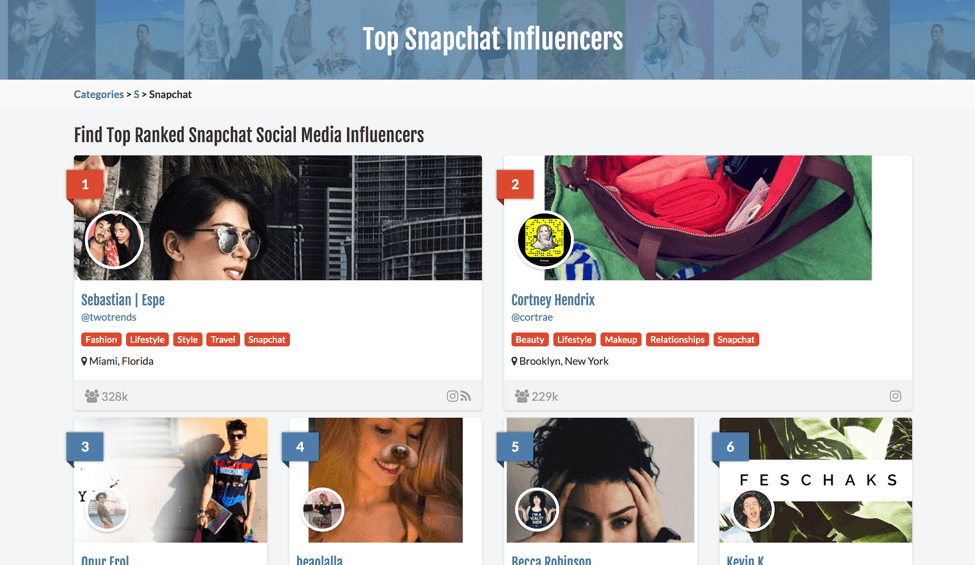
Additionally, you also get to see the interests of influencers in these marketplaces, which gives you an idea of whether or not the influencer will be suitable to be a part of your influencer marketing strategy.
In most cases, you’ll be able to comb through an influencer marketplace and dig up Snapchat profiles related to your niche. However, you’d be required to pay a sum to reach out to those influencers through the integrated tools.
For instance, the PRO version of Influence.co provides you with 5 influencer contacts per month and unlimited results per search, but you have to shell out $24.95 a both to use these features.
If your budget allows, go for the paid option as the entire process becomes quite convenient. Otherwise, you have to look up the influencer’s contact information in Google and reach out to them via email. We’ve left a few outreach templates in the next section of this chapter.
[highlight]Quick Tip: Think creatively about potential partners, as some influencers can be the right fit for ecommerce brands in different industries. For instance, an up-and-coming fashion blogger could also be an adventurer, which makes them an ideal choice for a clothing store as well as a travel-products brand.[/highlight]
Pinterest might not be as popular as Instagram when it comes to influencer use, but it’s still a platform worth considering. According to an official stat from Pinterest, 93 percent of users on Pinterest use it to plan purchases. Even more noticeable for ecommerce brands, 87 percent stated they’ve purchased a product after coming across it on Pinterest.
Although some pinners make it apparent on their profiles that they’re open for collaboration, here’s how to dig deep into the platform to find additional partnership opportunities:
Spy On Relevant Pinterest Boards
Collaborative boards, or groups, are owned by one account who gives one or more pinners permissions to add pins to the board. Pinterest’s search function allows you to search any keyword with the ‘boards’ filter applied, so you get to see just the boards that exist on the site for your entered keyword(s).
For instance, if you search for tech bloggers with the boards filter applied, Pinterest presents you with several boards set up by tech companies, up-and-comers, and micro-influencers. Look up the board owner’s profile (some have their sites mentioned too) to see if they’re a potential fit for your influencer marketing campaign.
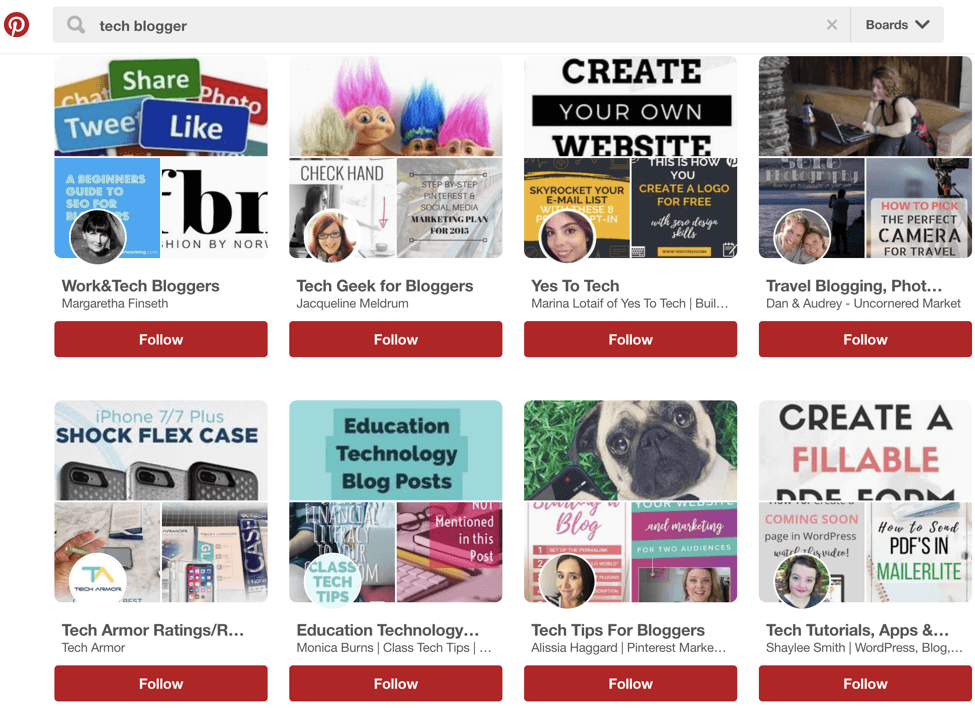
One of the boards for the above search is Educational Technology Blog Posts by Class Tech Tips. It’s owned by Monica Burns of Class Tech Tips.
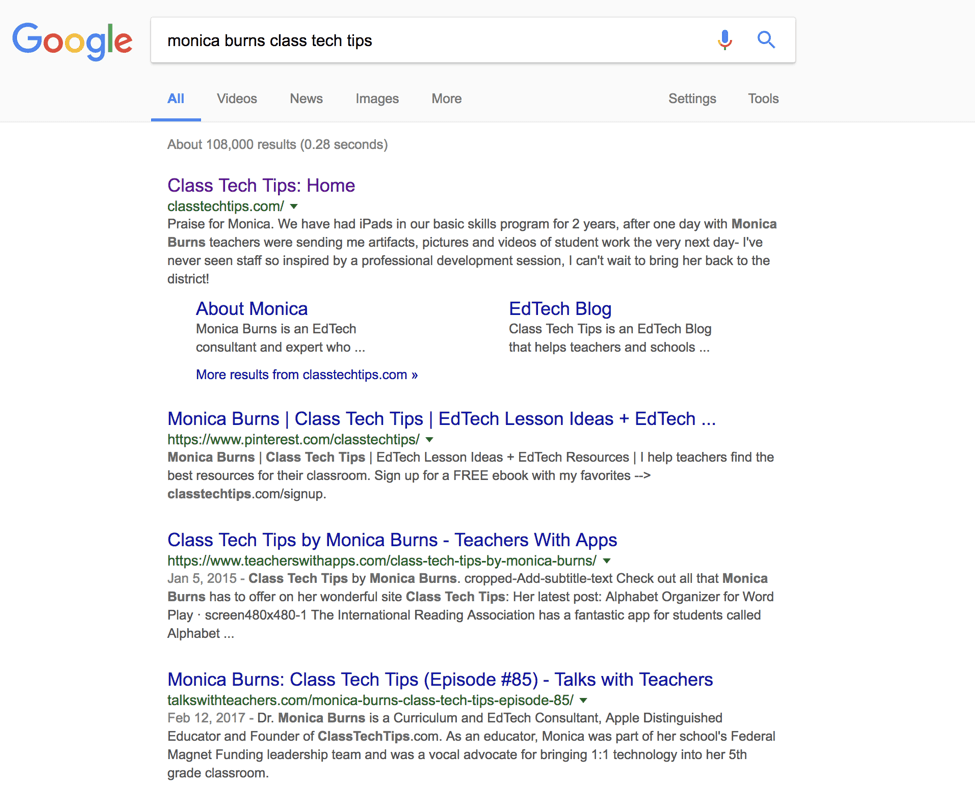
Enter her name in Google and you’ll see she has a decent online footprint. If you sell tech and gadgets like computers and accessories, she could be a potential collaborator who helps you reach new audiences.
Use Google
Just as in the case of Snapchat, you can use Google to find relevant Pinterest influencers. Try the following search strings:
- ‘Industry name’ Pinterest influencers
- Pinterest influencers for ‘industry name’
- List of ‘industry name’ influencers on Pinterest
For instance, if you’re selling subscription snack boxes, you can search ‘food Pinterest influencers’ on Google. Here’s what you get in return for this search:
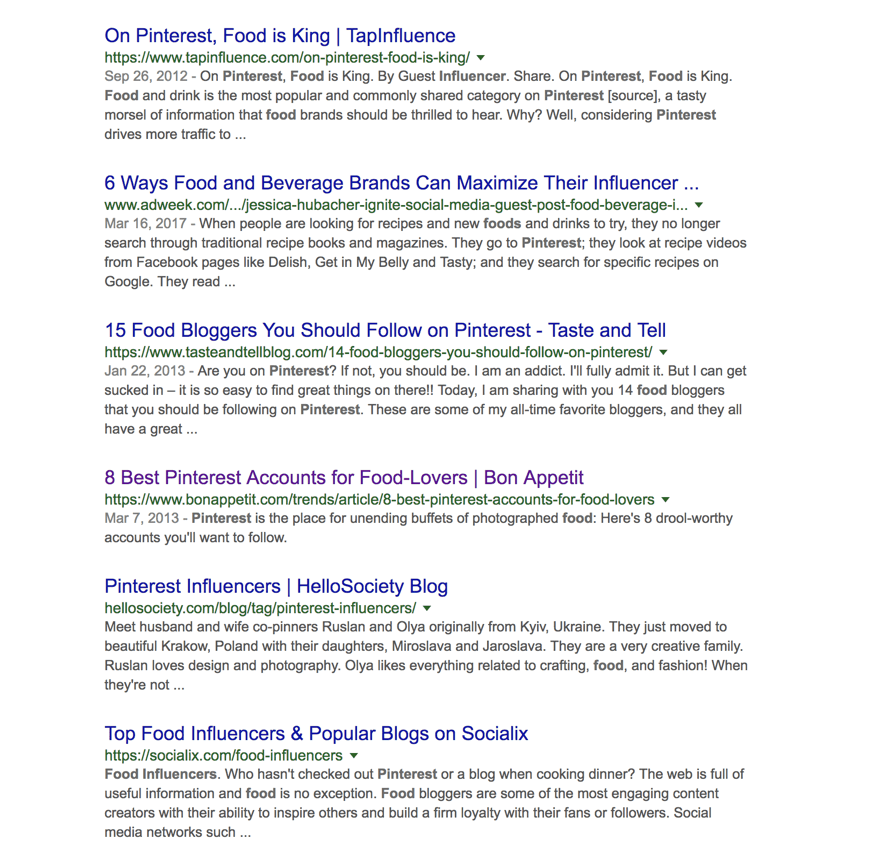
It’s likely that you’ll find a good list of influencers on one of the sites displayed in the search.
Tools that Can Help
There are dozens of tools that can help connect you with the best people for your influencer marketing campaigns. Here are just a few of the free or cheap ones:
This tool lets you search for popular content. By default, it is set to display results by time for any given search query. Users can see a list of 10 articles at a time. Sorting and filtering options include filter by time (today, current week or current month), filter by location, sort by relevance, filter by topic score, video views only, and use influencers.
The benefit of using Right Relevance is that it presents you with a list of results free of cost. For instance, if you search for superhero toys, here’s what you see in the tool:
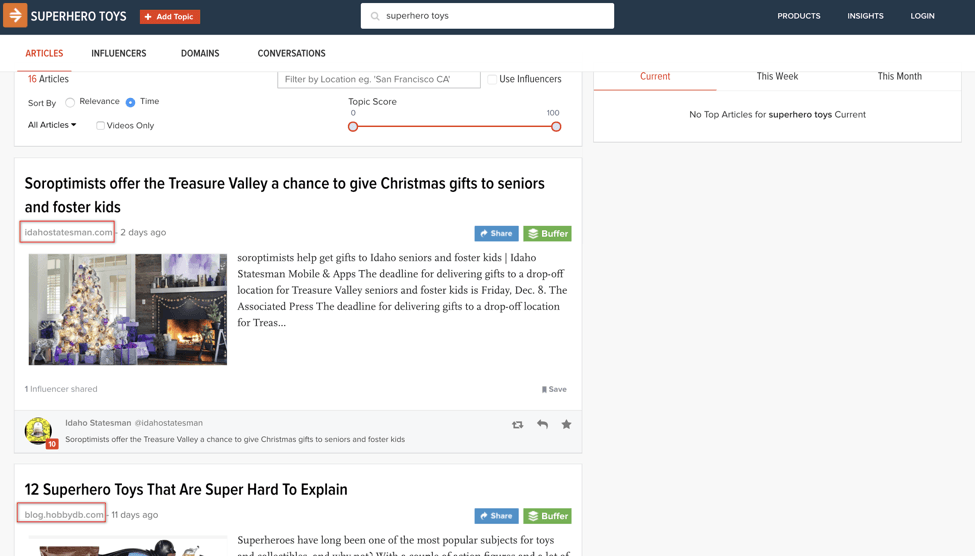
The site that posted the article is also mentioned. See if you can spot any new names to focus outreach efforts on.
Feedly is an RSS reader that allows you to manage all your content preferences in an easy to understand platform, saving time on research while also giving you access to all the latest industry news.
Type the topic or keyword you want to find related blogs for into the search box. Feedly then gives you suggestions on websites that have been tagged by other users with that keyword. For instance, if you search for golf accessories, here’s what Feedly shows:
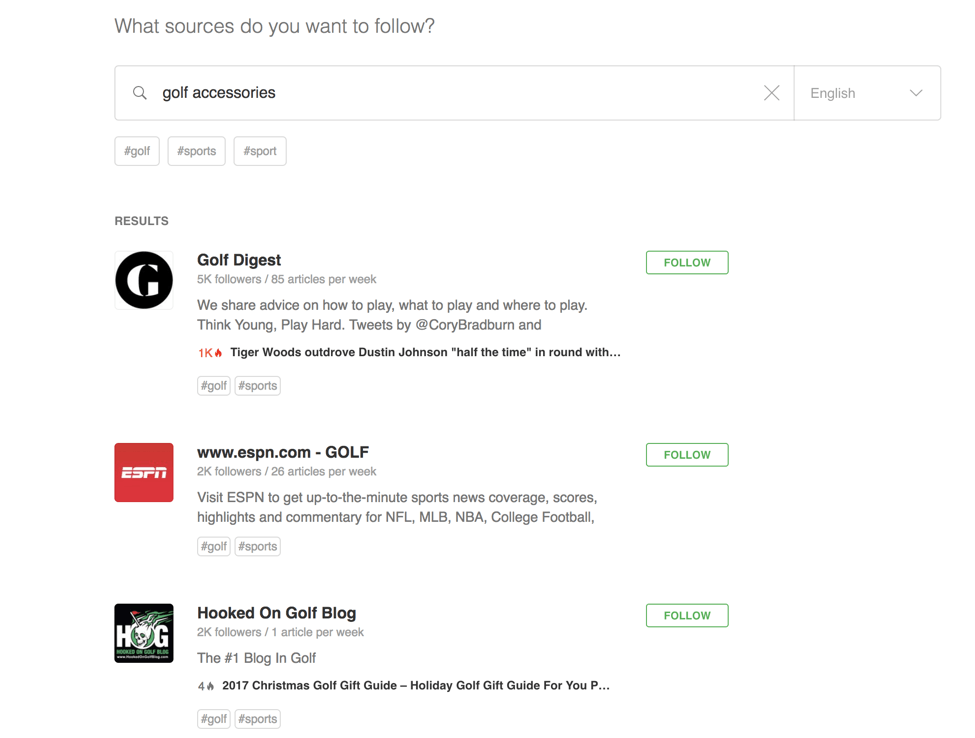
Clicking on a website’s name will open a window within Feedly that shows the rest of the content published on that site. To visit the website’s homepage, click on the site’s name again. You can then conduct outreach by emailing the site owner or editor. The search function is free to use.
2.4 Build a Contact List and Begin Outreach
In classic public relations style, make a ‘media list’, or a detailed Excel or Google Drive spreadsheet of everyone who could potentially form a part of your influencer marketing strategy.
Start with 50 influencers for your first round of outreach.
Include fields like:
- Name
- Email address
- Website name and URL
- Social media accounts
- Date you first reached out
- Whether they responded and when
- Any notes or ideas that stick out about how you can work together
Keep your spreadsheet organized and actionable by dividing contacts into tiers or categories, which can be done by creating multiple tabs in the spreadsheet file. For example: high, middle, and low priority tiers based on how beneficial the partnership initially looks, or categories for different types of influencer marketing ideas like guest blogging or podcast appearances (which we’ll discuss in-depth later in the chapter).

[highlight]Quick Tip: Download our ready-made Google Sheets template here.[/highlight]
Nurture from Cold to Warm Contacts
Now that you’ve identified who you’re going to target and put them all into a single, searchable, organized file, the next step is to make contact. Depending on who you’re pitching, these influencers could be receiving hundreds of requests a day, so you need to make sure your first contact stands out from the crowd.
A generic email pitch from a random source will most likely be sent straight to the trash, and blasting their social media feeds with pitches is a great way to get blocked. The key is to get noticed and build a relationship with the influencer, so when it comes time to pitch your influencer marketing idea, it won’t be completely out of the blue.
Influencers who contribute to those sites are often active on multiple channels, which means you’ll have plenty of opportunities to start engaging with them. Searching for the site owner’s/author’s name along with the publication’s name in Google should reveal the platforms he/she currently uses. For instance, you’ll get the following results if you search for Lori McDonald of Practical Ecommerce.
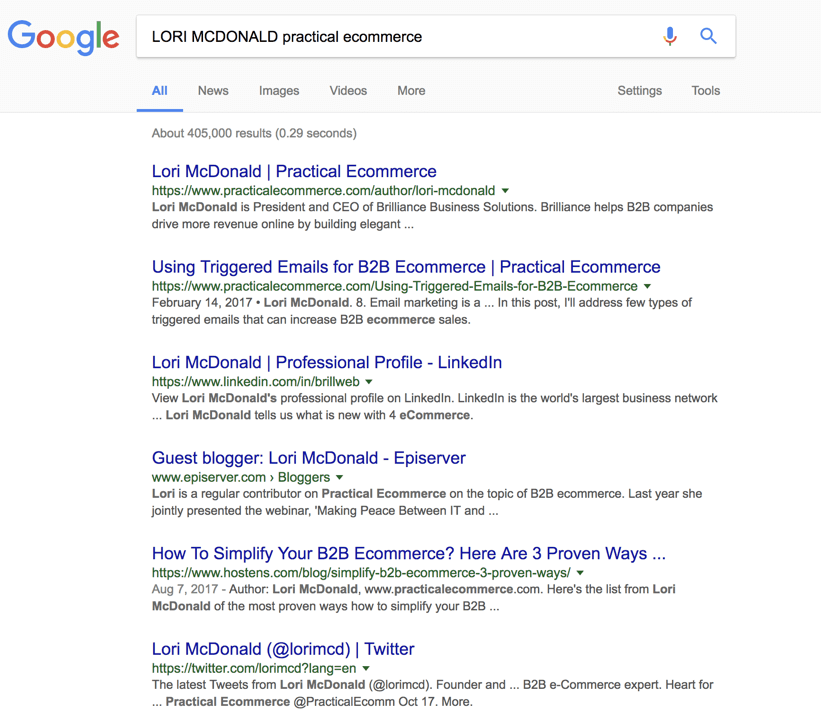
The results reveal the author has a presence on Twitter and some other channels.
Follow all of your target’s feed and channels and actually become a fan. Comment on their blog posts. Like, comment on, and share their social media posts. Contribute to discussions they may be leading on other channels. The best comments add relevant information to the influencer’s content while giving you a chance to demonstrate your expertise and shared interests. Here’s an example:
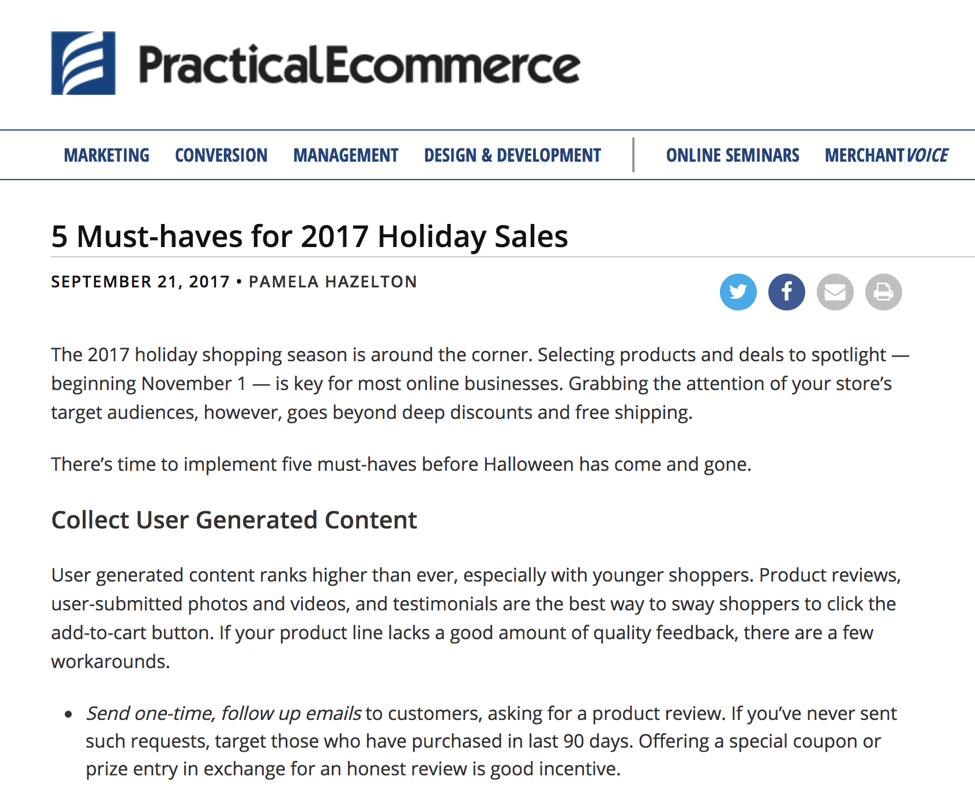
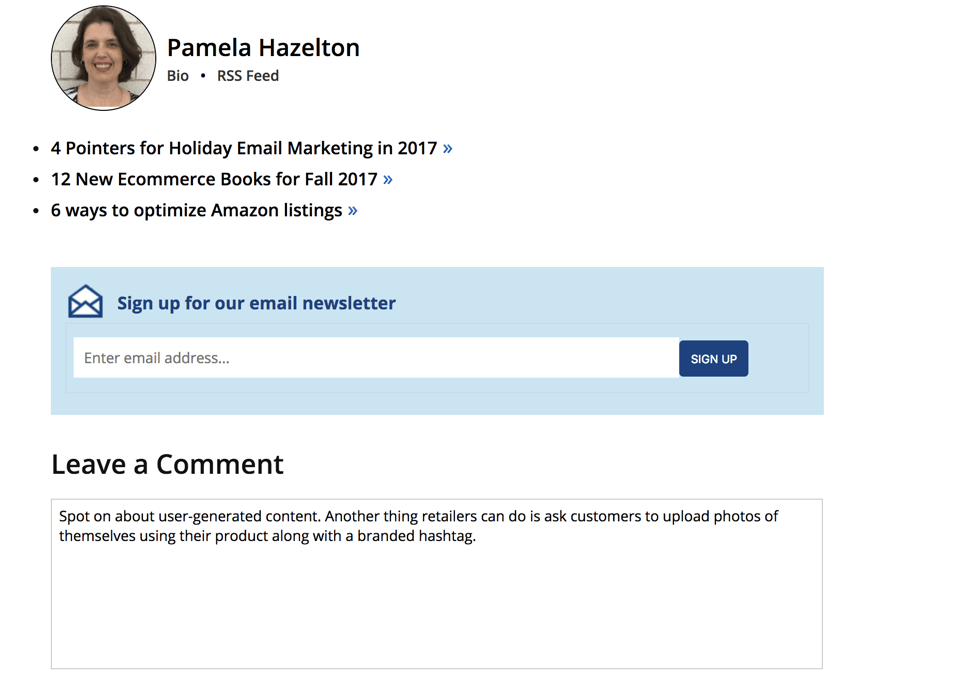
[highlight]Quick Tip: If the website has a newsletter or mailing list, sign up for it. When they send you the first email, send them a quick reply to let them know how much you appreciate their content, or use the opportunity to draw a soft connection to your brand. I don’t recommend going for a hard sell unless there’s a strong opportunity related to their newsletter content.[/highlight]
Does your target create great content? Use your own channels as a promotion tool. If you’re creating your own blog content (which we’ll discuss a bit later), you can link to their blog posts as reference pieces, share them on your social media and tag them in the body of the post, or go straight for a shout-out to let them know you appreciate their work. You can use your personal social media account to do all that, but I highly suggest using your branded company account for the following reasons:
- The host is more likely to notice a branded account rather than a personal account
- You can do a shout-out and increase its visibility by putting up a sponsored post for a few days.
It’s an easy choice, especially if the branded account has more followers.
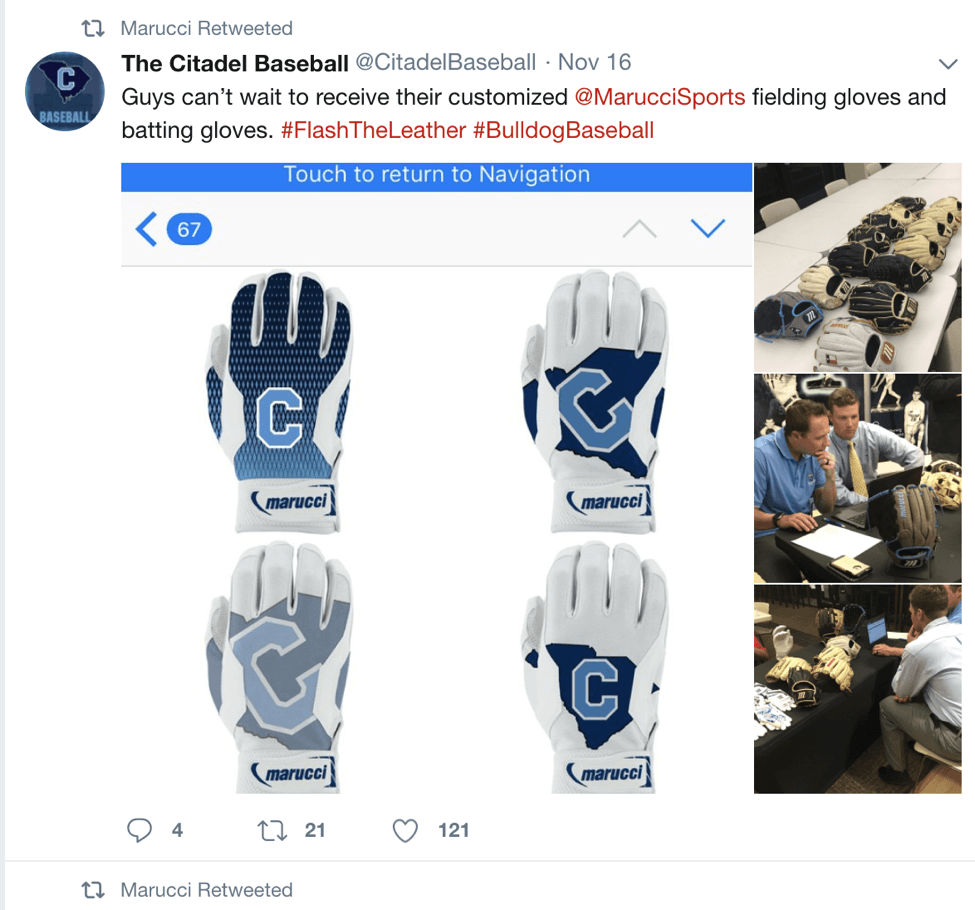
Sharing this content is beneficial for everyone involved – up-and-comers will appreciate you sharing their content and growing their network, your customers will appreciate interesting and relevant content from a reputable and reliable source, and you’ll save time that you would have otherwise spent writing original content.
A word of warning when engaging with the influencer: don’t overdo it! You want to present yourself as a respectful contact who can make valuable contributions. If the blogger starts engaging back with you, consider it a success. If you don’t get any response, there’s no need to worry. The most important thing is that you’re giving them a chance to start seeing your name.
[highlight]Quick Tip: As you’re exploring their online presence and looking for ways to warm up the relationship, pay attention to their opinions, tone, style, and subject matter. If anything sticks out or inspires you, add it to your spreadsheet notes.[/highlight]
Create Outreach Templates and Tweak Accordingly
If you haven’t already pitched a marketing opportunity during the previous stage, get working on your outreach strategy. If you’re planning to send an email, it should be unique and attention-grabbing while immediately communicating your brand’s personality and value.
While each outreach email should be tailored to a specific target, start off by building broader templates that you can later customize for each recipient. Here are some templates you can use to get started.
Let Them Know You Featured Them
Whenever you feature an up-and-comer in some of your own content, make sure you let them know about it. This can be a great way to introduce yourself and can help build a connection to your brand. What better way to build a connection than by instant flattery?
For this kind of outreach message, a straightforward subject line works best. Something like “Hi Sam! We featured you in one of our most popular posts” will increase the chances of your mail is opened.
Make sure you thank them and let them know that both you and your customers appreciate their opinions.
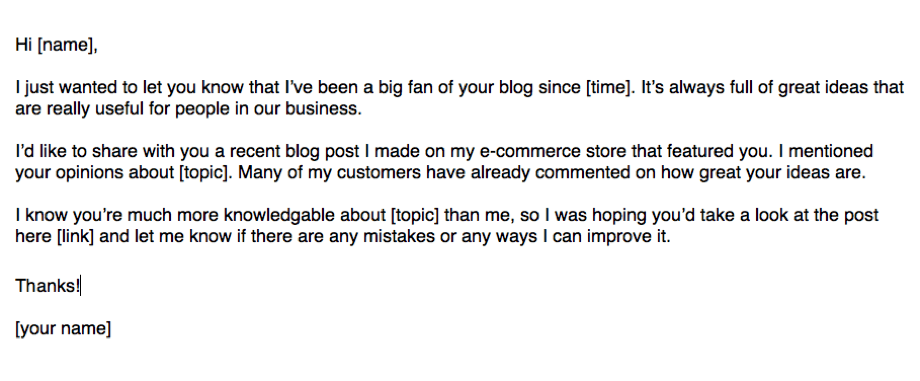
The most common way to contact an up-and-comer is through a simple introductory email. You don’t want your email sent straight to the spam folder, so start with a catchy subject line that grabs your target’s attention. A great example is something like “Hey – great post about natural face masks!”.
Complimenting their work and mentioning how they provide value is a good strategy when appealing to less experienced bloggers and newer websites. Make sure you keep the tone personal and friendly so they know it’s not just another cookie cutter pitch, and keep the content simple and to the point. Let them know you’re looking to start a relationship with them that will be mutually beneficial for both parties, but try to avoid being pushy.
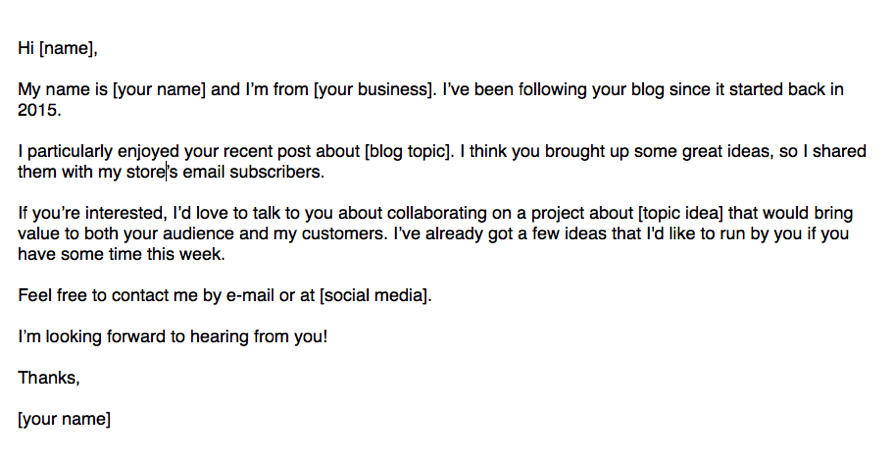
Up-and-comers want to know that their opinion is valued. Asking them for their feedback on your own ecommerce website is a great way to engage them while validating their efforts. If any of the content on your store contains research, opinions, or unique insights that you think might interest your target, simply let them know that both you and your audience would value their input.
Like the previous example, it’s always a good idea to compliment your target on their work. However, with this style of outreach, it can be even more effective to remind them of your own value. Let them know that their ‘expert opinion’ will be shared with both your customers and other influential members of your community.
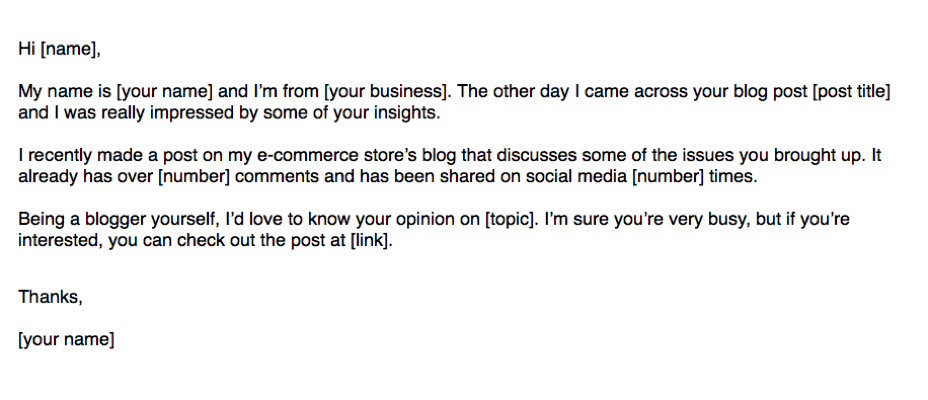
Up-and-coming influencers appreciate the chance to get news before their competition. If your store is planning to launch a new product or you become aware of a new development in your industry, try offering an exclusive sneak peek to your target. It will make them feel special and go a long way towards growing your relationship.
The key to an effective sneak peek outreach is making sure that the news is something the target can use on their own site. Visit their site to see what they’ve written about in the past. Take note of which topics appeal to their audience, so you’ll have a good idea of what kind of sneak peek will be most valued.
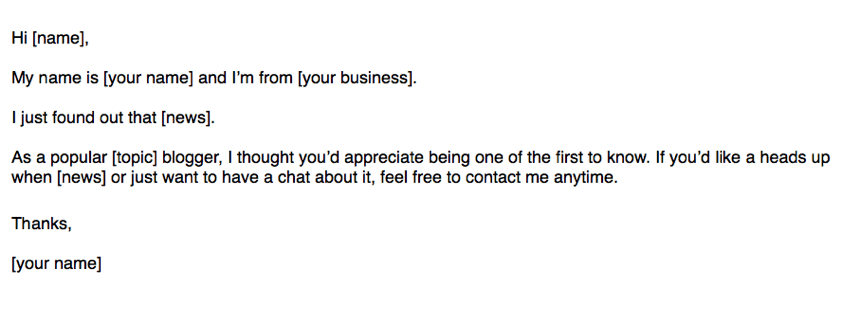
Ask for a Product Review
If you have the resources, consider offering bloggers a free sample in exchange for an honest review. This is a common request that many up-and-comers will receive, and a common strategy for companies to get product reviews. As with most outreach emails, you should be direct, but not demanding. Let them know that you appreciate their opinion and all you expect is an honest review.
A really effective strategy for free sample outreach is to send the target multiple samples. Give them one sample for their own personal use and some extra samples to give to their audience. They will undoubtedly appreciate your generosity and this simple gift could go a long way towards solidifying your relationship.
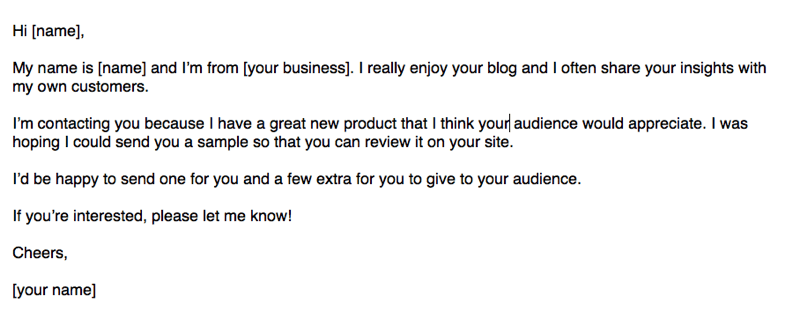
[highlight]Quick Tip: Keep your template bank organized and accessible by adding all of your templates into a single spreadsheet or word processing file. If you prefer multiple files, keep them all in a single folder.[/highlight]



Chapter 2 Takeaways
Dig deep into the web to identify 50 influencers to work with. Instead of chasing high-traffic influencers, go for smaller-scale micro-influencers or up-and-comers who are more genuinely interested in influencer marketing opportunities. To do this, you’ll need to spend several hours brainstorming ideas and conducting online searches using the steps and tips mentioned above.
As you find promising leads, add them to a spreadsheet like our outreach contact list template, along with notes that include any inspiration you have about how to work with them. For the outreach process, build email templates and tweak them to customize to each recipient.
To manage the workload and keep the whole process organized, put special attention into developing your own reliable system. Ensure that the same types of information are stored in the same place, so you’re not drowning in misplaced data. Consider creating a dedicated schedule where you work on research and outreach for two to three hours each day to avoid burnout and allow time for your strategy to evolve with the new information you find.

